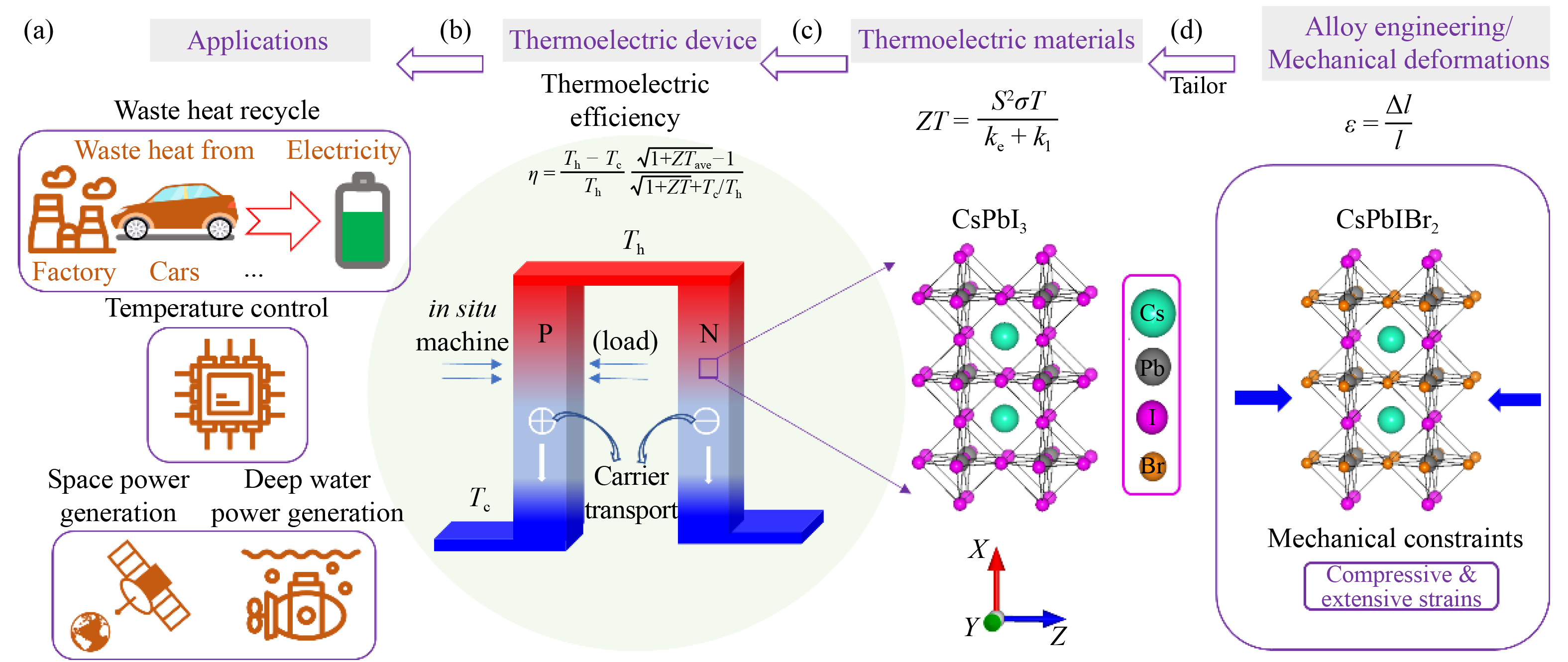The thermoelectric transport properties and
ZT values are mechanical deformation-tunable in inorganic metal halide perovskites, either by mechanical deformation or intrinsic strains caused by halogen mixing. These two factors can be combined synergistically to achieve remarkable
ZT values in CsPb(I
1–xBr
x)
3. For pure CsPbI
3 perovskite with three-fold degenerated Pb-6p orbitals, the maximum
ZT values can be enhanced from about 0.5 without strain to 0.55 with a strain of ±2% (e.g
.,
X-X,
Y-Y and
Z-Z). For mixed halide CsPbIBr
2 perovskite with two-fold degenerated Pb-6p orbitals, the maximum
ZT values can be enhanced from 1.7 without strain to 1.85 with a strain of ±2% (e.g
.,
X-X and
Y-X/
Z-X). Such high
ZT values (1.85 at 300 K) is even higher than the best commercialized and most reported Bi
2Te
3 based materials at room temperature, where the highest reports are the Fe-doped Bi
0.4Sb
1.6Te
3 (experimental
ZT = ~1.4) [
67], and Bi
0.5Sb
1.5Te
3 (experimental
ZT = 1.72) [
68]. For metal halide perovskites, the majority of the experimental reports on
ZT values are Sn-based [
14]. In contrast, the reported
ZT values are still low (below 0.2) for metal halide perovskites, and the highest reported
ZT value is 0.19 for (F4-TCNQ)-doped FASnI
3 [
69]. Therefore, more investigations and effects are urgently needed to experimentally verify the appealing theoretical reports [
14]. Finally, the power generation efficiency of the thermoelectric device as a function of the hot-side temperatures coming from different heat sources (room temperature at the cold-side) was estimated. As shown in Fig.9, the conversion efficiency is highly enhanced from CsPbI
3 (
ZT = 0.5) to CsPbIBr
2 (
ZT =1.85) under intrinsic strains and mechanical deformation, especially at high temperatures. Such high efficiency is comparable or even higher than many promising bulk thermoelectric materials [
70], (besides the Bi
2Te
3 series) including the multicomponent oxides series, CuSe composites series, SnSe series, half-Heusler series, GeTe/PbTe series, and etc. Herein, one experimental report of the promising thermoelectric materials among each series is chosen as examples, such as BiCuSeO (
ZT = ~0.45 at 300 K) [
71], α-Cu
2+xSe (experimental average
ZT = ~0.6 between 300 and 400 K) [
72], SnSe (
ZT = 0.8 at 300 K) [
73], TaFeSb (average
ZT = 0.93 between 300 and 973 K) [
74], Pb
0.98Na
0.02Te-8%SrTe (average
ZT = 1.2 between 300 and 800 K) [
75]. The power generation efficiency can reach as high as 4.9% (CsPbI
3) to 12% (CsPbIBr
2 under 1% extensive strain) at 500 K, and these enhancements suggest that mechanical deformation in combination with the alloy engineering are efficient and controllable strategies, and the thermoelectric device with such high efficiency is promising to be applied in thermoelectrical fields and recycle the waste heat.












